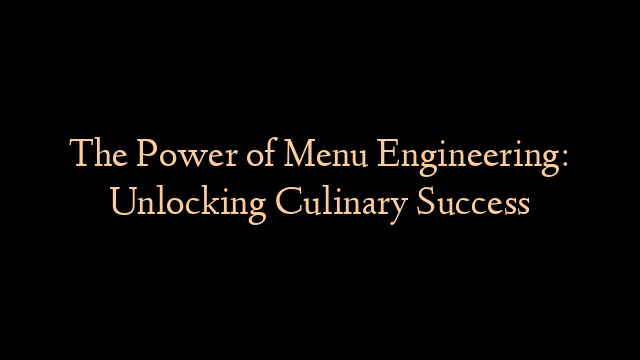In the symphony of the culinary world, menu engineering stands as a masterful conductor, orchestrating a harmonious balance of flavors, costs, and customer satisfaction. It is the art of crafting menus that not only tantalize taste buds but also maximize profitability, creating a culinary compass that guides restaurants towards success.
Taste the Triumph: Maximizing Menu Profitability
Menu engineering empowers restaurants to identify and promote high-profit items, while strategically positioning lower-profit dishes to enhance overall profitability. By analyzing sales data, calculating food costs, and understanding customer preferences, restaurants can optimize their menu to maximize revenue and minimize waste.
The Art of Menu Design: Enticing the Senses
A well-designed menu is a visual masterpiece that captivates the senses and entices customers to culinary adventures. From font choices to color schemes and photography, every element plays a role in creating a menu that is both aesthetically pleasing and easy to navigate. By understanding the principles of menu design, restaurants can create menus that effectively showcase their culinary creations.
The Science Behind the Plate: Balancing Flavors and Costs
Menu engineering involves a delicate balance between flavors and costs. By analyzing flavor profiles and customer preferences, restaurants can create dishes that satisfy taste buds while maintaining profitability. This requires careful consideration of ingredient combinations, portion sizes, and preparation methods, ensuring that every dish delivers a memorable culinary experience without compromising financial viability.
Unlocking Culinary Creativity: Inspiring Menu Innovation
Menu engineering fosters culinary creativity by encouraging chefs to experiment with new flavors and ingredients. By understanding customer preferences and market trends, restaurants can identify opportunities to introduce innovative dishes that expand their culinary repertoire and keep customers coming back for more.
The Symphony of Ingredients: Orchestrating Menu Combinations
Menu engineering is not merely about individual dishes; it is about creating a cohesive menu that offers a symphony of flavors and experiences. By carefully orchestrating menu combinations, restaurants can guide customers through a culinary journey, ensuring that each dish complements the next and leaves a lasting impression.
The Emotional Connection: Menus as Storytelling Tools
Menus are more than just lists of dishes; they are storytelling tools that connect restaurants with their customers. By weaving a narrative around their culinary creations, restaurants can evoke emotions and create a deeper connection with diners. Menus that tell the story behind the ingredients, the chef’s inspiration, or the restaurant’s history can enhance the dining experience and foster customer loyalty.
The Power of Presentation: Visualizing Culinary Delights
Presentation plays a crucial role in menu engineering. By carefully plating dishes and using visually appealing garnishes, restaurants can elevate the dining experience and create a lasting impression. From vibrant colors to intricate arrangements, presentation transforms ordinary dishes into culinary masterpieces that entice the senses and stimulate the appetite.
The Menu as a Marketing Masterpiece: Driving Sales and Loyalty
A well-crafted menu is a powerful marketing tool that drives sales and fosters customer loyalty. By highlighting popular dishes, promoting specials, and offering enticing descriptions, menus can create a desire for culinary indulgence. Restaurants can leverage menu engineering to upsell higher-profit items, encourage repeat visits, and build a loyal customer base.
The Art of Suggestion: Guiding Customers to Culinary Gems
Menu engineering involves the art of suggestion, subtly guiding customers towards dishes that align with the restaurant’s profitability goals. By strategically placing high-profit items in prominent sections of the menu or using suggestive language, restaurants can influence customer choices without being overly pushy.
The Psychology of Pricing: Optimizing Menu Value Perception
Pricing plays a pivotal role in menu engineering. By understanding the psychology of pricing, restaurants can optimize the perceived value of their dishes. Factors such as price anchoring, decoy pricing, and bundling can influence customer perceptions, leading to increased sales and improved profitability.
The Recipe for Success: Measuring and Refining Menu Performance
Menu engineering is an ongoing process that requires continuous measurement and refinement. By tracking sales data, analyzing customer feedback, and conducting menu testing, restaurants can identify areas for improvement and make informed decisions to enhance menu performance. Regular menu updates and adjustments ensure that menus remain relevant, profitable, and aligned with customer preferences.
Menu engineering is a transformative art that empowers restaurants to create menus that not only satisfy taste buds but also maximize profitability, inspire creativity, and forge emotional connections with customers. By embracing the principles of menu engineering, restaurants can elevate their culinary offerings, drive sales, and establish themselves as culinary destinations where diners embark on unforgettable gastronomic journeys.


